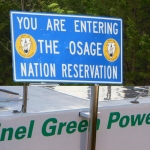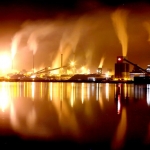US: Md. coal mining's toxic legacy
As cleanup funds dry up, officials mull what to do with mountains of waste
In the woods at the fringe of this Western Maryland town, a mountain of waste 50 feet high is slouching into a creek that's tinted an eerie orange.
The "gob pile" is refuse from a long-abandoned coal mine. And the stream into which it's eroding, Winebrenner Run, is devoid of life - one of the state's worst cases of sulfuric acid pollution from mines.
At least 40 of these potentially toxic heaps rise in the forested mountains of Allegany and Garrett counties like tombstones for the state's declining coal industry. The Maryland Department of the Environment would like to get rid of the piles because they often ooze acid and can spontaneously ignite.
But the funding to clean up this and other pollution left by the state's roughly 800 abandoned mines is scheduled to end next year as a federal tax on coal companies expires.
Even if money is found, there's a dispute over how to dispose of the waste heaps. Maryland is examining Pennsylvania's decision to burn coal waste to generate electricity, but some environmentalists say that's a bad idea because it creates mercury air pollution and leaves ash with heavy metals.
Mike Garner, chief of abandoned mine land programs for the Department of the Environment, stood in the gurgling waters of Winebrenner Run and looked up at the looming mass of gunk.
"We are worried about a big slug of gob eroding down and blocking that stream, flooding the homes nearby," Garner said, his shoes muddy with acidic orange silt. "We'd like to remove this pile and restore this stream."
The term gob stands for "garbage of bituminous." It is shorthand for the rocks that miners threw away near mine shafts as they dug toward veins of coal, said Daniel L. Welsch, an assistant professor at Frostburg State University who is studying the piles.
The tar-colored waste heaps - also called "bone piles" - are typically made up of shale, iron pyrite and other minerals mixed with coal. When iron pyrite (called fool's gold) is exposed to water and oxygen, it can create sulfuric acid, which sometimes leaks from the piles. More often, Welsch said, acid wells up from forgotten mine shafts near the heaps, turning streams into lifeless ditches.
The orange color is from iron that precipitates out of the water when acid is added, Welsch said. More than 350 miles of streams in Western Maryland are tainted by this pollution.
The worst problems are from scores of old mines that closed before 1977. After that, federal law required coal companies to clean up their waste and replant their sites with grass.
About 30 smaller mines are still active in Maryland. But the state's largest, run by Mettiki Coal LLC in Garrett County, closed in October, and the industry is shrinking here - even as it is growing nationally - because the most accessible coal veins in the state have been tapped out. What's left in Maryland is the industry's legacy.
"Gob piles are ugly - they release acid and iron, aluminum and manganese," said Tom Rathbun, a spokesman for the Pennsylvania Department of Environmental Protection. "And when the water comes out on the downstream edge, it's not quite battery acid, but nothing lives downstream."
Pennsylvania estimates that it has more than 250 million tons of waste coal in thousands of piles scattered across the state. It has begun burning the gob in power plants designed to handle the impurities, Rathbun said.
But some critics say that burning gob creates worse problems for the environment because it is an extra-dirty fuel that can spew mercury into the air.
"The amount of mercury in waste coal is far higher than in conventional coal, and you have to burn more of it to get the same amount of energy," said Mike Ewall, director of the Energy Justice Network, a Philadelphia-based nonprofit group. "It would be far better not to be burning this stuff, releasing all that toxic waste into the air and creating the waste ash for landfills."
Craig Hartsock, president of the nonprofit Maryland Resource Conservation and Development Council, said he'd like the gob piles in Western Maryland to be marketed as fuel for power plants.
"It would provide a useful source of fuel for electricity and clean up an environmental blight on the landscape at the same time," Hartsock said. "It would be a win-win situation."
He's working with Welsch and other researchers at Frostburg State to try to find all of the state's forgotten gob piles, by poring over old maps and tramping through woods.
John E. Carey, the director of Maryland's Bureau of Mines, said his agency has cleaned up 15 gob piles in the past two decades, including some of the largest, in Kempton, Eckhart, Shallmar and Kitzmiller. Workers flatten the piles with bulldozers, then cover the refuse with soil and grass. By burying the gob, the state reduces erosion into streams, Carey said.
But Carey expressed concern that the state's progress in cleaning up the waste will stop because Congress has not renewed the Surface Mine Control and Reclamation Act of 1977. The cleanup fees the law imposed on coal companies are set to expire in September.
The fees raised $293 million last year, of which $1.6 million went to Maryland, which ranks 18th among the states in coal production.
"It worries us to death," Carey said of the impending cutoff in federal funding. "It's one of the most successful environmental programs the nation has, with many coal mines turned back into productive land."
Congress has not reauthorized the tax because of protests from Wyoming - the nation's largest coal-producing state - that a disproportionate amount of the money came from Western coal companies but was shipped east to West Virginia, Pennsylvania, Maryland and other states with more abandoned mines, said Jim Zoia, Democratic staff director of the House Resources Committee.
"There were disagreements among members of coal-producing regions over how the fees should be distributed to the states," Zoia said.
And Republican leaders were not interested in continuing the tax on industry, Zoia said. With Democrats taking over control of Congress in January, West Virginia Rep. Nick J. Rahall II - who has many abandoned mines in his district - is in line to become chairman of the Resources Committee. Rahall is expected to push to reauthorize the fees, Zoia said.
With the federal money, Maryland's environmental agency has taken steps to clean up 82 miles of streams by installing 10 machines, called dosers, that add powdered lime to waterways to reduce acidity. The agency also has replanted about 2,000 acres of strip mines.
But that is only a fraction of the reclamation that state officials say is needed. It would cost $52 million to clean up Maryland's most urgent problems and take three decades at the current rate of funding, Garner estimated. A complete repair of the scars and poisoned rivers that pock the landscape of Western Maryland could cost more than $1 billion, he said.
"We have to do the most we can with the little money we have," Carey said.
One of the gob piles the state would like to remove is in Midland, south of Frostburg. It's in the Georges Creek valley, which is honeycombed with the some of the oldest abandoned mines in the country, a few dating to the 1700s.
The heap is a quarter-mile long and 50 feet tall, rising higher than the bell tower of the white clapboard Grace United Methodist Church, well above the rooftops in this rural town. It dates back more than a century to the Ocean Mine, dug by the Consolidation Coal Co.
When it rains, black sludge flushes down from the mountain and across the road. When the wind picks up, cars and houses get coated in dust.
Carl Schurg said his family used to consider the gob a blessing. Their home was heated with a coal furnace, and they scavenged all the fuel they needed by picking over the pile.
"When we were kids, we used to slide down it on shovels," laughed Schurg, a 61-year-old hospital maintenance worker. "We'd go home so dirty they'd beat our behinds."
But then his family and the neighbors switched to gas or oil furnaces, and they now view the mountain outside their doors as a nuisance.
"You can't even open your windows because that stuff will blow right into your house," Schurg complained.
Robert Burt, a 50-year-old corrections officer who lives across the street from the Midland mound, said he's tired of calling the county every time rain washes gob across the road.
"I'd like to see that pile gone, because it's disgusting," he said.
- 190 Natural Resources



